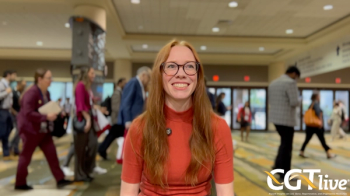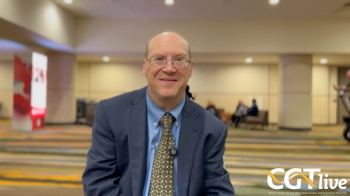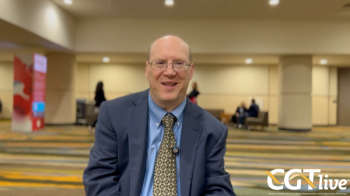
Lenvatinib/Everolimus Combo Submitted for Approval in Advanced RCC
Regulatory filings have been submitted in the United States and Europe for the combination of lenvatinib and everolimus as a treatment for patients with metastatic renal cell carcinoma following a VEGF-targeted therapy.
Hilary Glen, MB ChB, MSc, PhD
Regulatory filings have been submitted in the United States and Europe for the combination of lenvatinib (Lenvima) and everolimus (Afinitor) as a treatment for patients with metastatic renal cell carcinoma (RCC) following a VEGF-targeted therapy, according to a statement from Eisai, the company developing the multikinase inhibitor.
The applications were based on a phase II study, which showed a significant improvement in progression-free survival (PFS) with lenvatinib plus everolimus compared with everolimus alone. Median PFS with the combination was 14.6 versus 5.5 months with everolimus (HR, 0.40; 95% CI, 0.24-0.68; P <.001).
“The phase II data showed that, for people with metastatic kidney cancer, the addition of lenvatinib offered a statistically significant progression-free survival benefit compared to everolimus alone,” Hilary Glen, MB ChB, FRCP, MSc, PhD, consultant medical oncologist, Beatson West of Scotland Cancer Centre, Scotland, UK, said in a statement. “The news that Eisai has submitted this application is hugely positive, for both clinicians and patients alike. The current outlook for people with this aggressive cancer is poor, and therefore the potential of lenvatinib is very exciting indeed.”
Findings from the phase II study were presented at the 2015 ASCO Annual Meeting and published in Lancet Oncology.1,2 In the open-label study, 153 patients were randomized in a 1:1:1 ratio to lenvatinib plus everolimus (n = 51), lenvatinib monotherapy (n = 52), or everolimus monotherapy (n = 50). Crossover was not permitted in the study.
In the combination arm, lenvatinib was administered at 18 mg per day with everolimus at 5 mg daily. In the single-agent groups, everolimus was given at 10 mg/day and lenvatinib was administered at 24 mg/day.
The most common prior VEGF therapy received by patients in the trial was sunitinib, at 71%, 67%, and 56% in the combination, lenvatinib, and everolimus arms, respectively. Overall, 10%, 8%, and 14% of patients in the combination, lenvatinib, and everolimus arms received cytokine therapy or a checkpoint inhibitor, respectively.
Median OS was 25.5 months in the combination arm, 19.1 months in the lenvatinib monotherapy arm, and 15.4 months in the everolimus arm. The difference between the single-agent lenvatinib arm and the everolimus arm was 32% (HR = 0.68; P = .118) and there was a 49% improvement seen in survival for the combination versus everolimus (HR, 0.51; 95% CI, 0.30-0.88; P = .024).
The ORR was 43% in the combination arm, 27% with lenvatinib, and 6% with everolimus. The median duration of response was 13.1 months in the combination arm compared with 7.5 months and 8.5 months in the lenvatinib and everolimus monotherapy arms, respectively.
“The high-response rate and the longer OS results speak to the high-level of efficacy observed in the study for the combination,” lead investigator Robert Motzer, MD, an attending physician, Memorial Sloan Kettering Cancer Center, said when he presented the findings at ASCO. “Adverse events were generally higher for the lenvatinib-containing arms compared with everolimus. These adverse events were predictable, and generally managed with dose modifications.”
All patients experienced at least one treatment-emergent adverse event (AE) across all treatment arms. Treatment-related grade 3 AEs occurred in 71% of patients in the combination arm, 83% in the single-agent lenvatinib arm, and 52% in the everolimus arm.
The most frequently reported grade 3/4 treatment-emergent AE with the combination was diarrhea (20%). In the single-agent arms, the most common grade 3/4 AEs were proteinuria (19%) and anemia (12%) for lenvatinib and everolimus, respectively.
There were relatively few grade 4 events in any of the three arms; however, two grade 5 AEs were attributed to lenvatinib. Seventy-one percent of patients required a lenvatinib dose reductions in the combination arm compared with 62% in lenvatinib alone arm. Of those in the everolimus monotherapy arm, 26% required a dose reduction.
“Notably, there was a 20% incidence for grade 3 diarrhea in the combination arm, which highlights the need for recognition and management of this toxicity for the combination, in particular,” said Motzer.
The application for lenvatinib and everolimus was submitted to the FDA in November 2015. The agency assigns a review deadline within 60 days of receiving an application. In Europe, the application was submitted in January 2016; however, the European Medical Agency had already granted the combination an accelerated assessment in October 2015.
Lenvatinib is a highly potent tyrosine kinase inhibitor of both VEGF receptors and FGF receptors. In July 2015, lenvatinib received a breakthrough therapy designation from the FDA for patients with mRCC. Additionally, the FDA approved lenvatinib for patients with radioactive iodine refractory differentiated thyroid cancer in February 2015.
References
- Motzer R, Hutson T, Glen H, et al. Randomized phase 2 three-arm trial of lenvatinib (LEN), everolimus (EVE), and LNE+EVE in patients (pts) with metastatic renal cell carcinoma (mRCC). J Clin Oncol. 2015;33 (suppl; abstr 4506).
- Motzer RJ, Hutson TE, Michaelson MD, et al. Lenvatinib, everolimus, and the combination in patients with metastatic renal cell carcinoma: a randomised, phase 2, open-label, multicentre trial. Lancet Oncol. 2015;16(15):1473—1482.
The median PFS was 14.6 months for lenvatinib plus everolimus, 7.4 months for lenvatinib alone, and 5.5 months for everolimus. Lenvatinib monotherapy improved PFS by 29% versus everolimus monotherapy (HR, 0.61; 95% CI, 0.38-0.98; P = .048). However, the combination did not show a statistically significant improvement in PFS compared with lenvatinib monotherapy (HR, 0.66; 95% CI, 0.30—1.10; P = .12).
Newsletter
Stay at the forefront of cutting-edge science with CGT—your direct line to expert insights, breakthrough data, and real-time coverage of the latest advancements in cell and gene therapy.
















































